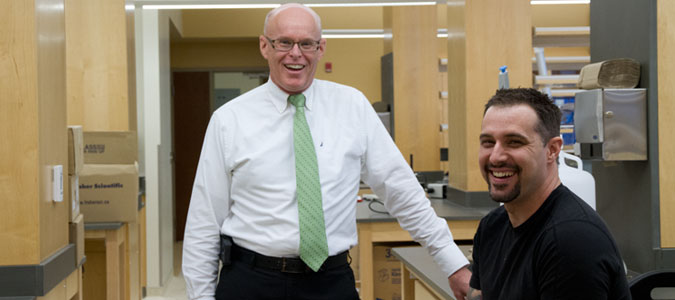Moving Day
Through a wall of windows along the hallway, visitors to D Wing of the Health Sciences building can watch what it takes to set up a scientific laboratory—an extraordinary amount of lifting, piling, unpacking, sorting and organizing. Here, there is no such thing as moving “day”; it is more like moving month.
By Kris Foster With all of the building commissioning hurdles now cleared, the process of bringing together researchers into group labs has begun, and will continue until the summer of 2014, according to Curtis Larson, associate director of operations in the Council of Health Science Deans Office. It can be delicate work but mostly it is hard work that requires meticulous planning and scheduling, said Larson, and so far, things are going well.
With all of the building commissioning hurdles now cleared, the process of bringing together researchers into group labs has begun, and will continue until the summer of 2014, according to Curtis Larson, associate director of operations in the Council of Health Science Deans Office. It can be delicate work but mostly it is hard work that requires meticulous planning and scheduling, said Larson, and so far, things are going well.
Larson led a tour of the transitional cancer research lab that will eventually house five principal researchers and their staff. Visible through the hallway windows are rows of research benches, still-crated equipment and piles of boxes. With windows on the exterior wall providing natural light, Larson said some have commented that the labs feel like fishbowls but the design is intentional.
"This building is about interprofessional, interdisciplinary teaching and research so students walking by are going to be able to watch that in action," he said. "Some people have asked for blinds on the windows, frosted glass or even if they can pile boxes to block the view but the answer is no to all of those."
Key to the move in process is a permanent crew of four from materials handling in the Facilities Management Division (FMD). Marty Schaan heads that crew which moves up to 2,300 kg of equipment a day from labs all over campus. "We're always sore at the end of the day," he said. "It comes with the job."
Schaan works with Larson as well as with office and lab staff to co-ordinate what moves when. Much of the equipment is new and must be moved in shipping crates, the largest so far being a cell sorter that weighed in at 1,270 kg. Existing equipment may end up out of alignment due to being moved but Larson said nothing has been damaged.
Karen Mochoruk, the cancer lab's head technologist, said there is a lot of excitement around the move. She expects it will be month before the lab is fully operational in Health Sciences and, until then, the current lab in the Saskatoon Cancer Centre is winding down but not shutting down. The goal is "a very smooth transition" from one space to another.
Grouping researchers in shared lab space is a new concept at the U of S, said Larson, "and we're all going to have to make this work together. The culture will have to change immensely."
One researcher who has concerns about moving into a shared lab in Health Sciences is Jeremy Lee, professor of biochemistry in the College of Medicine. "Basically I've been assigned a bench," he said, as much as 50 per cent less space than he currently has in his lab, and that may actually slow down his research. The limited space will mean cleaning up and getting out new equipment every time the work changes rather than having room to conduct more than one experiment at a time. "In this new culture, that won't really be possible.
"And the idea of sharing equipment has problems of its own," he continued. "It's human nature—if you share equipment, you don't look after it like you would your own, or clear up what you've just finished … and that is exacerbated by a lack of space."
Lee, who does single molecule research into protein folding and misfolding, is scheduled to move into the molecular design lab in Health Sciences with five other principal investigators, and a sixth to come later. He estimates over 50 people will be using the same lab "and there's no getting around the fact there's much less space."
He is also concerned that graduate students will not be located close enough to the research benches. Three of his students have been assigned space on the same floor as the new lab, but on the other side of the building. A fourth will be housed three floors up. "It's an odd and inefficient design," he said.
Typically, researchers and students have desk space very close to research benches so they can do other work while experiments are running. In the new lab, "you can't multitask because your desk is too far away, and that's one of the most important lessons students have to learn."
Even Lee's own desk is further from the benches than he would like. "As it is now, if a student drops a flask or starts swearing, I'm right there. If you can rectify it quickly, you can probably go on with the experiment but if you don't get there in time, it can ruin a whole day. Being on site is very important."
Lee said he knows that others share his concerns and is hopeful the problems will be resolved "but the college (of medicine) keeps talking about expanding to accommodate more researchers and they're already out of space. They need to start building a new building now if that's their plan."

